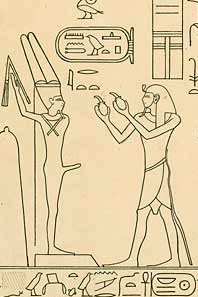Mentuhotep IV
| Mentuhotep IV | |
|---|---|
 Mentuhotep IV (right) gives offerings to Min. From Wadi Hammamat | |
| Pharaoh | |
| Reign | 1997–1991 BC[1] (11th dynasty) |
| Predecessor | Mentuhotep III |
| Successor | Amenemhat I |
| Mother | Imi |
| Died | 1991 BC |
Nebtawyre Mentuhotep IV was the last king of the 11th Dynasty. He seems to fit into a 7-year period in the Turin Canon for which there is no recorded king.
Rock inscriptions[]
He is known from a few inscriptions in Wadi Hammamat that record expeditions to the Red Sea coast and to quarry stone for the royal monuments. One of these inscriptions confirms the name of his mother to be Imi. It seems that he was a son of his predecessor.
Also, he is attested by the inscriptions at Wadi el-Hudi.[5] Another relevant inscription is found in Ain Sukhna.[6] These locations were the usual staging harbours for the expeditions to the Sinai.
Despite Mentuhotep's obscurity (he is absent from the official Abydos king list), the inscriptions show the organization and makeup of a large expedition during his reign. The leader of an expedition to Wadi Hammamat, during the second year of Mentuhotep IV’s reign, was his vizier, Amenemhat, who is assumed to be the future king Amenemhat I, the first king of the 12th Dynasty, and Mentuhotep's immediate successor.
A fragment of a slate bowl found at Lisht North was regarded for a long time to be inscribed on the outside with the official titulary of Mentuhotep IV, and on the inside with that of King Amenemhat I, his successor. Since the two inscriptions are incised in a different style of writing, according to Dorothea Arnold, this indicates that Amenemhat had his name added to an older vessel that already bore the name of Mentuhotep IV.[7] However, Peter Janosi showed that Mentuhotep IV is not mentioned on the bowl, the titulary preserved there fits better to Mentuhotep II.[8]
End of reign[]
It is assumed by some Egyptologists that Amenemhat either usurped the throne or assumed power after Mentuhotep IV died childless. There is currently no archaeological or textual evidence to prove that Mentuhotep was deposed by his vizier or that he chose Amenemhat to be his designated successor. Neither his mummy nor his burial place have been found.
See also[]
References[]
- ^ Stewart, John (2006). African States and Rulers (Third ed.). London: McFarland. p. 81. ISBN 0-7864-2562-8.
- ^ King List (chronological)
- ^ Clayton, Peter A. Chronicle of the Pharaohs: The Reign-by-Reign Record of the Rulers and Dynasties of Ancient Egypt. Thames & Hudson. p72. 2006. ISBN 0-500-28628-0
- ^ Mentuhotep IV's titulary on Eglyphica.de
- ^ Fakhry, Ahmed (1952). The Inscriptions of the Amethyst Quarries at Wadi el Hudi.
- ^ El-Raziq, Mahmoud Abd (2002). Les Inscriptions d'Ayn Southna. ISBN 9782724703221. |page=4a and 4b }}
- ^ Dorothea Arnold, Amenemhat I and the Early Twelfth Dynasty at Thebes. Metropolitan Museum Journal, v. 26 (1991)
- ^ Jánosi, Peter (2010). "Montuhotep-Nebtawyre and Amenemhat I: Observations on the Early Twelfth Dynasty in Egypt". Metropolitan Museum Journal. 45: 7–20. doi:10.1086/met.45.41558050.
Further reading[]
| Wikimedia Commons has media related to Mentuhotep IV. |
- Grajetzki, Wolfram (2006-02-24). The Middle Kingdom of Ancient Egypt: History, Archaeology and Society. pp. 25–26. ISBN 9780715634356.
- Pharaohs of the Eleventh Dynasty of Egypt
- 20th-century BC Pharaohs
- 20th-century BC deaths
- Ancient Egypt people stubs
